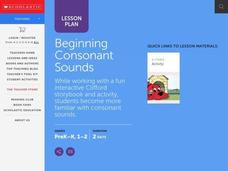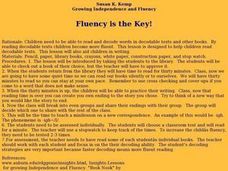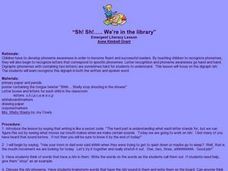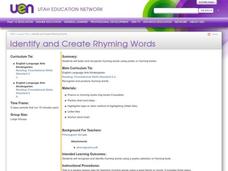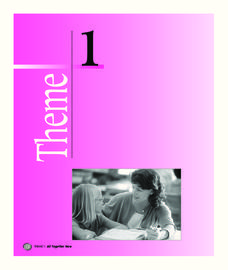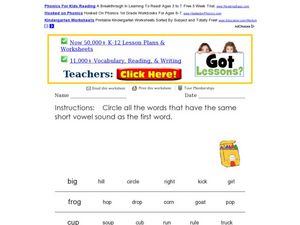Curated OER
Long Vowel Sounds
In this long vowel sounds worksheet, 2nd graders recognize vowel sounds. Students say words and then color the section according to sound. There are eight words in the picture and four different vowel sounds.
Curated OER
Initial Sound Accuracy, Same Sound!
Students study words. For this phonemic awareness lesson, students play a game in which they identify if two words have the same initial sound. They play the game in pairs using a stack of word cards prepared by the teacher. This lesson...
Curated OER
Time to Rhyme
Students sing along to a hello song. They develop skills of phonemic awareness, literacy and social awareness. They think of words that rhyme with their names to add to the song.
Curated OER
Beginning Consonant Sounds
Young readers practice their beginning consonant sounds. Solid worksheets prompt students to practice their consonant in fun ways. These worksheets use Clifford the Big Red Dog as a theme, and give the kids excellent and colorful practice.
Curated OER
ABC It's as Easy as 1-2-3!
Help readers explore initial letter sounds. They will choose a letter of the alphabet and create a page for a classroom "ABC" book. They will write down various words that begin with their assigned letter and draw a picture to go in the...
Little Book Lane
"Ch" Words
What do chug and chain have in common? The consonant digraph ch of course. Hold onto your hats – here is a packet of worksheets with enough practice activities to fill a short unit. It contains two lists of ch words, three practice...
Curated OER
Fluency is the Key!
A field trip to the library begins this lesson plan where children select their own books to practice fluent silent reading. They then practice their writing by creating a new ending to the story they chose before receiving a mini-lesson...
Curated OER
That Tricky Letter T
Students practice writing and working with the letter T from the alphabet in order to recognize the letter in words that have it in them. They assess the book, "The Berenstain Bears Visit the Dentist," view picture cards and then...
Curated OER
Sh! Sh! We're in the Library
Young scholars focus on the diagraph of sh. They recognize this in both the written and spoken word. To introduce this instructional activity, the teacher asks if anyone's mom or dad has told them shhhh, when they were trying to get...
Curated OER
Beat the Heat
First graders are introduced to the concept of vowel digraphs. They identify the digraph /ea/ in written and spoken language. After a brief discussion, 1st graders apply the rule for identifying and spelling words containing the /ea/...
Curated OER
Sneeze Cheese
Students study the /ch/ digraph by thinking of the sound that is made when someone sneezes. They listen to a tongue twister while identifying how many times they hear the /ch/ sounds and make words using the Elkonin boxes and letters....
Curated OER
I'm going to chase you
First graders identify the digraphs in written and spoken language. After a brief discussion of the combinations of /c/ and /h/ that comprise the /ch/ digraph, 1st graders practice identifying initial and final placement of the digraph...
Curated OER
Identify and Create Rhyming Words
Students discuss rhyming word families and read stories that present those families in rhyme. They generate rhyming words, manipulate sentence strips to pair rhymes and sort pictures of rhyming words.
Curated OER
Big, Bad, "B" and "D"
Students practice discerning between the letters D and B. Through hands on and listening activities, they recognize the difference between the commonly confused letters B and D. They practice writing both letters and correcting common...
Curated OER
Bouncing and Dancing with B and D
Students explore the differences between the letters b and d. They practice seeing the letters and hearing the sounds with words and tongue twisters. They practice letter formation for both letters and listen to the book, The...
Curated OER
Rain Rain Go Away
Complete a variety of activities related to the long /a/ sound with a focus on words containing the ai and ay correspondence with your readers. As a class, they recite a tongue twister, then spell different words containing ay and ai...
Houghton Mifflin Harcourt
Surprise!: Extra Support Lessons (Theme 2)
Surprise! is the theme of a unit covering such topics as consonants, blending, short vowels sounds, high frequency words, and number words. The unit's lessons also include teachable moments covering story structure, illustrations,...
Houghton Mifflin Harcourt
All Together Now: Extra Support Lessons (Theme 1)
All Together Now is the theme of this series of extra support lessons. The collection aids the instruction of blending sounds and reading high-frequency words through writing and reading sentences. Support also engages pupils...
Curated OER
Poetry Workshop: Fixed Form Poems
Encourage the poetic genius in your young creative writers with a poetry workshop. Fix form poems (cinquains acrostic poems, octopoems, hello/goodbye poems) provide a framework and encourage vocabulary development as well as an awareness...
Curated OER
Chicken Soup With Rice
Complete a variety of activities related to the Maurice Sendak's book Chicken Soup With Rice. Readers identify the months of the year, identify words starting with the letter J, explore online illustrations created by Maurice Sendak, and...
Curated OER
Technopoet - Poetry Lesson Plans
Practice word processing while writing different types of poems. First, elementary and middle schoolers use Word templates to write poetry. They use rhyming and descriptive words as they work with clipart, text wrapping, and picture...
Scholastic
Digraph sh
Shhhh! Listen up to learn about the sh digraph. With the materials provided here, kids will have the opportunity to hear, say, write, and read this particular digraph many times.
Curated OER
Short Vowel Sounds
Some vowels make the same sound, like the vowels in grow and both. Read the words on the left hand side of the page (there are six) and match them to a similarly sounding word on the right hand side.
Curated OER
Short Vowel Sound
Use this creative way to review words that have short vowel sounds. Learners read a word and then identify the words in the group that have the same vowel sound. It is a motivating way to have learners explore this topic.



